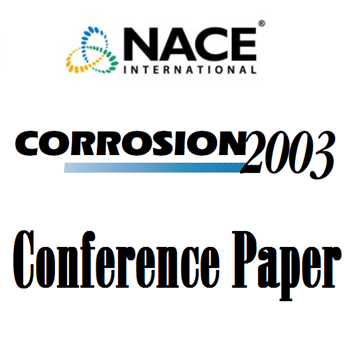Search
Products tagged with 'h2s'
View as
Sort by
Display
per page
02235 IMPROVEMENTS ON DE WAARD-MILLIAMS CORROSION PREDICTION AND APPLICATIONS TO CORROSION MANAGEMENT
Product Number:
51300-02235-SG
ISBN:
02235 2002 CP
Publication Date:
2002
$20.00
02554 SOHIC RESISTANCE OF C-Mn PLATE STEELS USED IN REFINERY SERVICE
Product Number:
51300-02554-SG
ISBN:
02554 2002 CP
Publication Date:
2002
$20.00
03534 EVALUATION OF HYDROGEN EMBRITTLEMENT OF S13CR STAINLESS STEELS BASED ON SSR AND CTOD TESTING
Product Number:
51300-03534-SG
ISBN:
03534 2003 CP
Publication Date:
2003
$20.00
06156 OPERATIONAL LIMITS FOR AUSTENITIC STAINLESS STEELS IN H2S-CONTAINING ENVIRONMENTS
Product Number:
51300-06156-SG
ISBN:
06156 2006 CP
$20.00
10349 Prediction and Assessment of Ammonium Bisulfide Corrosion Under Refinery Sour Water Service Conditions-Part 2
Product Number:
51300-10349-SG
ISBN:
10349 2010 CP
Publication Date:
2010
$20.00
51316-7119-Sour Service Performance of EPR - 110ksi Grade Material
Product Number:
51316-7119-SG
ISBN:
7119 2016 CP
Publication Date:
2016
$20.00
51316-7209-Evaluation of Full Size C110 Premium Casing Connections Fit-for-Purpose Performance in Mildly Sour Environment
Product Number:
51316-7209-SG
ISBN:
7209 2016 CP
Publication Date:
2016
$20.00
51316-7333-Comparison of Corrosion Behavior in HIC Test Solutions for FFP evaluation
Product Number:
51316-7333-SG
ISBN:
7333 2016 CP
Publication Date:
2016
$20.00
51316-7340-Investigation of Cathodic Reaction Mechanisms of H2S Corrosion Using a Passive SS304 Rotating Cylinder Electrode
Product Number:
51316-7340-SG
ISBN:
7340 2016 CP
Publication Date:
2016
$20.00
51317-9113-Stress Corrosion Cracking Of A Duplex Stainless Steel
Product Number:
51317-9113-SG
ISBN:
9113 2017 CP
Publication Date:
2017
$20.00
51317--9542-Silicon-Based CVD Nanocoatings for Corrosion Resistance and Advanced Surface Properties
Product Number:
51317--9542-SG
ISBN:
9542 2017 CP
Publication Date:
2017
$20.00
51317--9551-Identification of Compounds that Effectively Block Microbial H2S Production
Product Number:
51317--9551-SG
ISBN:
9551 2017 CP
Publication Date:
2017
$20.00











